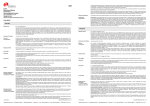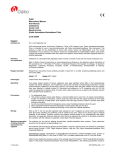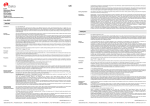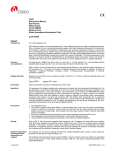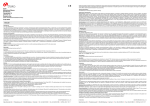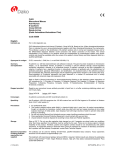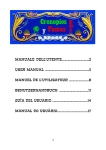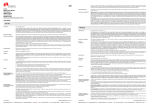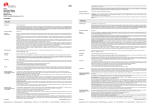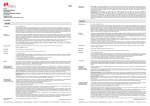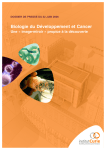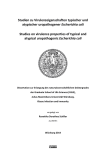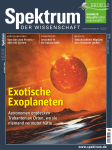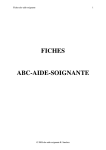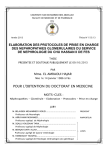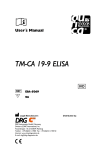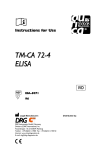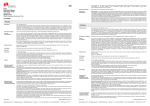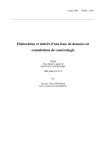Download FLEX Monoclonal Mouse Anti-Human CD31, Endothelial
Transcript
Counterstaining in hematoxylin is recommended using EnVision FLEX Hematoxylin, (Dako Autostainer/Autostainer Plus) (Code K8018). Non-aqueous, permanent mounting medium is recommended. Positive and negative controls should be run simultaneously using the same protocol as the patient specimens. The positive control tissue should include colon and tonsil and the cells/structures should display reaction patterns as described for these tissues in “Performance characteristics” in all positive specimens. The recommended negative control reagent is FLEX Negative Control, Mouse, (Dako Autostainer/Autostainer Plus) (Code IS750). FLEX Monoclonal Mouse Anti-Human CD31, Endothelial Cell Clone JC70A Ready-to-Use (Dako Autostainer/Autostainer Plus) Staining interpretation Cells labeled by the antibody predominantly display membrane staining, with weaker cytoplasmic staining Performance characteristics Normal tissues: The antibody labels endothelial cells in a wide range of tissues, including endothelium in renal glomerular capillaries and the endothelium of vasa vasorum. In addition, the antibody labels megakaryocytes and occasional plasma cells in bone marrow (1). In frozen sections of human tonsil and spleen the antibody labels some non-endothelial cells, including some mantle zone B cells and T cells. In blood smears, the antibody labels neutrophil polymorphs, 50% of the lymphocytes, all of the monocytes, and platelets (1). In colon, the endothelial cells of the large vessels show a moderate to strong staining reaction, whereas B cells in the mantle zone of tonsils show a weak to moderate staining reaction. Abnormal tissues: The antibody labels endothelial cells in a variety of benign and malignant vascular lesions. In 10/10 (1) and 6/7 (2) angiosarcomas, respectively, the antibody labeled malignant vascular endothelial cells. Further, the antibody labeled 17/17 (2) and 3/3 (1) hemangiomas, respectively, 3/3 epithelioid hemangiomas, 1/1 papillary endovascular angioendothelioma (2), 3/3 angiofibromas, 2/2 angiokeratomas, 1/1 hemangiopericytoma, 1/1 chemodectoma, 3/3 atrial myxomas and 2/2 cystic hygromas (1). In addition, the antibody labeled endothelial cells in tumor tissues with angiogenesis (3-5). In lymphangiomas discrepant results have been observed as the antibody was reported to label 8/8 (2) and 0/4 (1) cases, respectively. Likewise for glomus tumors, where 2/2 (1) and 0/7 (2) cases were labeled by the antibody. No labeling was observed in one case each of lymphoepithelial cyst and pneumatosis coli (1), negative were also all of 30 benign, and 4 malignant nerve sheath tumors, 11 dermatofibromas, 28 dermatofibrosarcoma protuberans, 6 leiomyomas, 3 leiomyosarcomas, 3 giant cell fibroblastomas (2), 52 rhabdomyosarcomas, 16 small round cell tumors, 11 neuroblastomas, 23 Wilms’ tumors, 20 retinoblastomas, 13 esthesioneuroblastomas, and 7 small noncleaved cell malignant lymphomas. Additionally, spindle cells in 17 cases of Kaposi’s sarcomas were uniformly negative (8). Code IS610 ENGLISH For in vitro diagnostic use. Intended use FLEX Monoclonal Mouse Anti-Human CD31, Endothelial Cell, Clone JC70A, Ready-to-Use, (Dako Autostainer/Autostainer Plus), is intended for use in immunohistochemistry together with (Dako Autostainer/ Autostainer Plus instruments. This antibody primarily labels endothelial cells, and is useful for the identification of benign and malignant vascular disorders, including angiosarcomas (1, 2). In addition, this antibody is valuable for the labeling of vessels when determining angiogenesis in several types of tumors (3-5). The clinical interpretation of any staining or its absence should be complemented by morphological studies using proper controls and should be evaluated within the context of the patient's clinical history and other diagnostic tests by a qualified pathologist. Synonym for antigen PECAM-1 (platelet/endothelial cell adhesion molecule 1) (6). Summary and explanation CD31 is a single chain type 1 transmembrane protein with a molecular mass of approximately 135 kDa, belonging to the immunoglobulin superfamily. In human serum, alternatively spliced versions of CD31 have been detected, including a form apparently lacking a transmembrane domain, but including the cytoplasmic tail (6). CD31 binds in both a homophilic and heterophilic manner. The heterophilic ligands include heparan sulfate glycosaminoglycans, heparin, and the integrin avb3. CD31 plays a role in adhesive interactions between adjacent endothelial cells as well as between leucocytes and endothelial cells. The ligation of CD31 to the surfaces of leucocytes results in upregulation of the functional leucocyte integrins, and the leucocyte diapedesis across the endothelium involves homophilic CD31 interactions. In addition, heterophilic CD31 interaction has a separate role in the migration of monocytes across the subendothelial basal lamina (6). CD31 is expressed on all continuous endothelia, including those of arteries, arterioles, venules, veins, and non-sinusoidal capillaries, but it is not expressed on discontinuous endothelium in e.g. splenic red pulp. In addition, CD31 is expressed diffusely on the surfaces of megakaryocytes, platelets, myeloid cells, natural killer cells, and some subsets of T cells, as well as on B-cell precursors (6). FRANÇAIS Pour utilisation diagnostique in vitro. Utilisation prévue FLEX Monoclonal Mouse Anti-Human CD31, Endothelial Cell, clone JC70A, Ready-to-Use, (Dako Autostainer/Autostainer Plus), est destiné à une utilisation en immunohistochimie avec les instruments (Dako Autostainer/ Autostainer Plus). Cet anticorps primaire marque les cellules endothéliales et facilite l’identification des troubles vasculaires bénins et malins, y compris les angiosarcomes (1, 2). En outre, cet anticorps s’avère utile pour le marquage des vaisseaux lors de la détermination de l’angiogenèse dans divers types de tumeurs (3-5). L’interprétation clinique de toute coloration ou son absence doit être complétée par des études morphologiques en utilisant des contrôles appropriés et doit être évaluée en fonction des antécédents cliniques du patient et d’autres tests diagnostiques par un pathologiste qualifié. Synonyme de l’antigène PECAM-1 (molécule d’adhérence cellulaire plaquette/cellule endothéliale 1) (6). Résumé et explication La CD31 est une protéine transmembranaire à simple chaîne de type 1 dont le poids moléculaire est d’environ 135 kDa et qui appartient à la superfamille des immunoglobulines. Dans le sérum humain, plusieurs variants de la CD31 provenant d’un épissage alternatif ont été identifiés, dont une forme qui ne présente apparemment pas de domaine transmembranaire mais qui comporte une queue cytoplasmique (6). La CD31 se lie de manière homophile ou hétérophile. Les ligands hétérophiles incluent les glycosaminoglycanes héparane sulfate, l’héparine et l’intégrine avb3. La CD31 joue un rôle dans les interactions d’adhérence entre les cellules endothéliales adjacentes, ainsi qu’entre les leucocytes et les cellules endothéliales. La ligature de la CD31 à la surface des leucocytes provoque une régulation à la hausse des intégrines leucocytaires fonctionnelles, tandis que la diapédèse leucocytaire à travers l’endothélium implique des interactions homophiles de la CD31. En outre, l’interaction hétérophile de la CD31 joue un rôle distinct dans la migration des monocytes à travers la lame basale sous endothéliale (6). Refer to Dako’s General Instructions for Immunohistochemical Staining or the detection system instructions of IHC procedures for: 1) Principle of Procedure, 2) Materials Required, Not Supplied, 3) Storage, 4) Specimen Preparation, 5) Staining Procedure, 6) Quality Control, 7) Troubleshooting, 8) Interpretation of Staining, 9) General Limitations. La CD31 est exprimée sur tous les endothéliums continus, notamment ceux des artères, artérioles, veinules, veines et capillaires non sinusoïdes, mais elle n’est pas exprimée sur l'endothélium discontinu tel la pulpe rouge de la rate. Par ailleurs, la CD31 est exprimée de manière diffuse à la surface des mégacaryocytes, des plaquettes, des cellules myéloïdes, des cellules NK et de certains lymphocytes T, ainsi que sur certains précurseurs des lymphocytes B (6). Ready-to-use monoclonal mouse antibody provided in liquid form in a buffer containing stabilizing protein and 0.015 mol/L sodium azide. Reagent provided Clone: JC70A (1). Isotype: IgG1, kappa. Immunogen Cell membrane preparation from the spleen of a patient with hairy cell leukemia (1). Specificity Anti-Human CD31, Endothelial Cell, clone JC70A, was clustered as anti-CD31 at the Fifth International Workshop and Conference on Human Leucocyte Differentiation Antigens (7). The epitope recognized was found to be within the extracellular domain 1 (6). In Western blotting of membrane preparations from a spleen rich in the antigen or from normal platelets, the antibody labels bands of respectively 100 kDa and 130 kDa, the latter corresponding to classic CD31. The smaller band of 100 kDa observed with the splenic preparation may be due to proteolytic breakdown or to variations in glycosylation (1). 1. For professional users. Precautions 2. This product contains sodium azide (NaN3), a chemical highly toxic in pure form. At product concentrations, though not classified as hazardous, sodium azide may react with lead and copper plumbing to form highly explosive build-ups of metal azides. Upon disposal, flush with large volumes of water to prevent metal azide build-up in plumbing. Se référer aux Instructions générales de coloration immunohistochimique de Dako ou aux instructions du système de détection relatives aux procédures IHC pour plus d’informations concernant les points suivants : 1) Principe de procédure, 2) Matériels requis mais non fournis, 3) Conservation, 4) Préparation des échantillons, 5) Procédure de coloration, 6) Contrôle qualité, 7) Dépannage, 8) Interprétation de la coloration, 9) Limites générales. Réactifs fournis Anticorps monoclonal de souris prêt à l’emploi fourni sous forme liquide dans un tampon contenant une protéine stabilisante et 0,015 mol/L d’azide de sodium. Immunogène Préparation de membrane cellulaire issue de la rate d’un patient atteint d’une leucémie à cellules chevelues (1). Spécificité L’anticorps Anti-Human CD31, Endothelial Cell, clone JC70A a été classé comme un anti-CD31 à la Fifth International Workshop and Conference on Human Leucocyte Differentiation Antigens (Cinquième Conférence et Atelier Internationaux sur les Antigènes de Différenciation des Leucocytes Humains) (7). L’épitope reconnu s’est avéré appartenir au domaine extracellulaire 1 (6). Clone : JC70A (1). Isotype : IgG1, kappa. Lors d’une analyse par Western blot de préparations de membrane provenant d'une rate riche en antigène ou de plaquettes normales, l’anticorps marque des bandes de 100 kDa et 130 kDa, respectivement, ce qui correspond traditionnellement à la CD31 dans le deuxième cas. La plus petite bande (100 kDa) observée avec la préparation de rate peut être due à une dégradation protéolytique ou à des variations de la glycosylation (1). 3. As with any product derived from biological sources, proper handling procedures should be used. 4. Wear appropriate Personal Protective Equipment to avoid contact with eyes and skin. 5. Unused solution should be disposed of according to local, State and Federal regulations. 1. Pour utilisateurs professionnels. Précautions Storage Store at 2-8 °C. Do not use after expiration date sta mped on vial. If reagents are stored under any conditions other than those specified, the conditions must be verified by the user. There are no obvious signs to indicate instability of this product. Therefore, positive and negative controls should be run simultaneously with patient specimens. If unexpected staining is observed which cannot be explained by variations in laboratory procedures and a problem with the antibody is suspected, contact Dako Technical Support. 2. Ce produit contient de l’azide de sodium (NaN3), produit chimique hautement toxique dans sa forme pure. Aux concentrations du produit, bien que non classé comme dangereux, l’azide de sodium peut réagir avec le cuivre et le plomb des canalisations et former des accumulations d’azides métalliques hautement explosives. Lors de l’élimination, rincer abondamment à l’eau pour éviter toute accumulation d’azide métallique dans les canalisations. Specimen preparation including materials required but not supplied The antibody can be used for labeling formalin-fixed, paraffin-embedded tissue sections. Tissue specimens should be cut into sections of approximately 4 µm. 4. Porter un vêtement de protection approprié pour éviter le contact avec les yeux et la peau. Pre-treatment with heat-induced epitope retrieval (HIER) is required. Optimal results are obtained by pretreating tissues using EnVision FLEX Target Retrieval Solution, High pH (10x), (Dako Autostainer/Autostainer Plus) (Code K8012/K8014). 3. Comme avec tout produit d’origine biologique, des procédures de manipulation appropriées doivent être respectées. 5. Les solutions non utilisées doivent être éliminées conformément aux réglementations locales et nationales. Conservation Conserver entre 2 et 8 °C. Ne pas utiliser après la date de péremption indiquée sur le flacon. Si les réactifs sont conservés dans des conditions autres que celles indiquées, celles-ci doivent être validées par l’utilisateur. Il n’y a aucun signe évident indiquant l’instabilité de ce produit. Par conséquent, des contrôles positifs et négatifs doivent être testés en même temps que les échantillons de patient. Si une coloration inattendue est observée, qui ne peut être expliquée par un changement des procédures du laboratoire, et en cas de suspicion d’un problème lié à l’anticorps, contacter l’assistance technique de Dako. Préparation des échantillons y compris le matériel requis mais non fourni L’anticorps peut être utilisé pour le marquage des coupes de tissus inclus en paraffine et fixés au formol. L'épaisseur des coupes d'échantillons de tissu doit être d’environ 4 µm. Deparaffinized sections: Pre-treatment of deparaffinized formalin-fixed, paraffin-embedded tissue sections is recommended using Dako PT Link (Code PT100/PT101). For details, please refer to the PT Link User Guide. Follow the pre-treatment procedure outlined in the package insert for EnVision FLEX Target Retrieval Solution, High pH (10x), (Dako Autostainer/Autostainer Plus) (Code K8012/K8014). The following parameters should be used for PT Link: Pre-heat temperature: 65 °C; epitope retrieval temperature and time: 97 °C for 2 0 (±1) minutes; cool down to 65 °C. Rinse sections with dil uted room temperature EnVision FLEX Wash Buffer (10x), (Dako Autostainer/Autostainer Plus) (Code K8012). Paraffin-embedded sections: As alternative specimen preparation, both deparaffinization and epitope retrieval can be performed in the PT Link using a modified procedure. See the PT Link User Guide for instructions. After the staining procedure has been completed, the sections must be dehydrated, cleared and mounted using permanent mounting medium. Coupes déparaffinées : Le pré-traitement des coupes de tissus déparaffinés fixés au formol et inclus en paraffine est recommandé à l’aide du Dako PT Link (Réf. PT100/PT101). Pour plus de détails, se référer au Guide d’utilisation du PT Link. The tissue sections should not dry out during the treatment or during the following immunohistochemical staining procedure. For greater adherence of tissue sections to glass slides, the use of Dako Silanized Slides (Code S3003) is recommended. Staining procedure including materials required but not supplied Suivre la procédure de pré-traitement indiquée dans la notice pour la EnVision FLEX Target Retrieval Solution, High pH (10x), (Dako Autostainer/Autostainer Plus) (Réf. K8012/K8014). Les paramètres suivants doivent être utilisés pour le PT Link : Température de préchauffage : 65 °C; température et durée de restauration de l’épitope : 97 °C pour 20 (±1) minut es ; laisser refroidir jusqu’à 65 °C. Rincer les coupes avec un EnVision FLEX Wash Buffer (10x), dilué à température ambiante (Dako Autostainer/Autostainer Plus) (Réf. K8012). The recommended visualization system is EnVision FLEX+, Mouse, High pH, (Dako Autostainer/Autostainer Plus) (Code K8012). The staining steps and incubation times are pre-programmed into the software of Dako Autostainer/Autostainer Plus instruments, using the following protocols: Template protocol: FLEXRTU2 (200 µL dispense volume) or FLEXRTU3 (300 µL dispense volume)Autoprogram: CD31 (without counterstaining) or CD31H (with counterstaining) Coupes incluses en paraffine : Comme préparation alternative des échantillons, le déparaffinage et la restauration de l’épitope peuvent être réalisés dans le PT Link à l’aide d’une procédure modifiée. Se référer aux instructions du Guide d’utilisation du PT Link. Une fois que la procédure de coloration est terminée, les coupes doivent être déshydratées, lavées et montées à l’aide d’un milieu de montage permanent. The Auxiliary step should be set to “rinse buffer” in staining runs with ≤10 slides. For staining runs with >10 slides the Auxiliary step should be set to “none”. This ascertains comparable wash times. All incubation steps should be performed at room temperature. For details, please refer to the Operator’s Manual for the dedicated instrument. If the protocols are not available on the used Dako Autostainer instrument, please contact Dako Technical Services. Optimal conditions may vary depending on specimen and preparation methods, and should be determined by each individual laboratory. If the evaluating pathologist should desire a different staining intensity, a Dako Application Specialist/Technical Service Specialist can be contacted for information on reprogramming of the protocol. Verify that the performance of the adjusted protocol is still valid by evaluating that the staining pattern is identical to the staining pattern described in “Performance characteristics”. (115222-002) Dako Denmark A/S IS610/EFG/LPF/09.10.07 p. 1/4 | Produktionsvej 42 | DK-2600 Glostrup | Denmark | Tel. +45 44 85 95 00 | Fax +45 44 85 95 95 | CVR No. 33 21 13 17 Le prétraitement avec un démasquage d’épitope induit par la chaleur (HIER) est nécessaire. Des résultats optimaux sont obtenus en prétraitant les tissus à l’aide de la EnVision FLEX Target Retrieval Solution, High pH (10x), (Dako Autostainer/Autostainer Plus) (Réf. K8012/K8014). Les coupes de tissus ne doivent pas sécher lors du traitement ou lors de la procédure de coloration immunohistochimique suivante. Pour une meilleure adhérence des coupes de tissus sur les lames de verre, il est recommandé d’utiliser des lames Dako Silanized Slides (Réf. S3003). Procédure de coloration y compris le matériel requis mais non fourni Le système de visualisation recommandé est le EnVision FLEX+, Mouse, High pH, (Dako Autostainer/Autostainer Plus) (Réf. K8012). Les étapes de coloration et d’incubation sont préprogrammées dans le logiciel des instruments Dako Autostainer/Autostainer Plus, à l’aide des protocoles suivants : Protocole modèle : FLEXRTU2 (volume de distribution de 200 µL) ou FLEXRTU3 (volume de distribution de 300 µL) Autoprogram : CD31 (sans contre-coloration) ou CD31H (avec contre-coloration). (115222-002) Dako Denmark A/S IS610/EFG/LPF/09.10.07 p. 2/4 | Produktionsvej 42 | DK-2600 Glostrup | Denmark | Tel. +45 44 85 95 00 | Fax +45 44 85 95 95 | CVR No. 33 21 13 17 L’étape Auxiliary doit être réglée sur « rinse buffer » lors des cycles de coloration avec ≤10 lames. Pour les cycles de coloration de >10 lames, l’étape Auxiliary doit être réglée sur « none ». Cela confirme des temps de lavage comparables. Vorbehandlung gemäß der Beschreibung in der Packungsbeilage für EnVision™ FLEX Target Retrieval Solution, High pH (10x), (Dako Autostainer/Autostainer Plus) (Code-Nr. K8012/K8014) durchführen. Für PT Link sollten die folgenden Parameter verwendet werden: Vorwärmtemperatur: 65 °C; Temperatur und Zeit für Epitopdemaskierung: 97 °C für 20 (±1) Minuten; auf 65 °C abkühlen lassen. Schnitte mit auf Raumtemperatur ge brachtem, verdünntem EnVision™ FLEX Wash Buffer (10x) (Dako Autostainer/Autostainer Plus) (Code-Nr. K8012) abspülen. Toutes les étapes d’incubation doivent être effectuées à température ambiante. Pour plus de détails, se référer au Manuel de l’opérateur spécifique à l'instrument. Si les protocoles ne sont pas disponibles sur l’instrument Dako Autostainer utilisé, contacter le service technique de Dako. Paraffineingebettete Schnitte: Zur Probenpräparation kann für Entparaffinierung und Epitopdemaskierung im PT Link auch ein modifiziertes Verfahren verwendet werden. Weitere Informationen siehe PT Link-Benutzerhandbuch. Nach Abschluss des Färbeverfahrens müssen die Schnitte dehydriert, geklärt und unter Verwendung eines permanenten Fixiermittels auf die Objektträger aufgebracht werden. Les conditions optimales peuvent varier en fonction du prélèvement et des méthodes de préparation, et doivent être déterminées par chaque laboratoire individuellement. Si le pathologiste qui réalise l’évaluation désire une intensité de coloration différente, un spécialiste d’application/spécialiste du service technique de Dako peut être contacté pour obtenir des informations sur la re-programmation du protocole. Vérifier que l'exécution du protocole modifié est toujours valide en vérifiant que le schéma de coloration est identique au schéma de coloration décrit dans les « Caractéristiques de performance ». Il est recommandé d’effectuer une contre-coloration à l’aide d’hématoxyline EnVision FLEX Hematoxylin, (Dako Autostainer/Autostainer Plus) (Réf. K8018). L’utilisation d’un milieu de montage permanent non aqueux est recommandée. Des contrôles positifs et négatifs doivent être réalisés en même temps et avec le même protocole que les échantillons du patient. Le contrôle de tissu positif doit comprendre l’amygdale et le côlon et les cellules/structures doivent présenter des schémas de réaction tels que décrits pour ces tissus dans les « Caractéristiques de performance » pour tous les échantillons positifs. Le contrôle négatif recommandé est le FLEX Negative Control, Mouse, (Dako Autostainer/Autostainer Plus) (Réf. IS750). Interprétation de la coloration Les cellules marquées par l’anticorps présentent principalement une coloration membranaire, avec une faible coloration cytoplasmique. Caractéristiques de performance Tissus sains : L’anticorps marque les cellules endothéliales dans divers tissus, notamment l’endothélium dans les capillaires glomérulaires rénaux et l’endothélium des vasa vasorum. En outre, l’anticorps marque les mégacaryocytes et parfois les cellules plasmatiques de la moelle osseuse (1). Dans les coupes congelées d'amygdale et de rate humaine, l’anticorps marque certaines cellules non endothéliales, notamment certains lymphocytes B et T de la zone du manteau. Dans les frottis sanguins, l’anticorps marque les neutrophiles polymorphes, 50 % des lymphocytes, tous les monocytes et les plaquettes (1). Dans le côlon, les cellules endothéliales des gros vaisseaux présentent une réaction modérée à forte, alors que la coloration des lymphocytes B dans la zone du manteau de l’amygdale est faible à modérée. Tissus tumoraux : Cet anticorps marque les cellules endothéliales dans diverses lésions vasculaires bénignes et malignes. Dans 10 cas sur 10 (1) et 6 cas sur 7 (2) d’angiosarcomes, respectivement, l’anticorps a marqué des cellules endothéliales vasculaires malignes. En outre, l’anticorps a marqué 17 cas sur 17 (2) et 3 cas sur 3 (1) d’hémangiomes, respectivement, 3 cas sur 3 d’hémangiomes épithélioïdes, 1 cas sur 1 d’angioendothéliome endovasculaire papillaire (2), 3 cas sur 3 d’angiofibromes, 2 cas sur 2 d’angiokératomes, 1 cas sur 1 d’hémangiopéricytome, 1 cas sur 1 de chémodectome, 3 cas sur 3 de myxomes atriaux et 2 cas sur 2 d’hygromas kystiques (1). L’anticorps a également marqué les cellules endothéliales des tissus tumoraux présentant une angiogenèse (3-5). Dans les lymphangiomes, des résultats divergents ont été observés car l’anticorps aurait marqué 8 cas sur 8 (2) et 0 cas sur 4 (1), respectivement. De même, pour les tumeurs glomiques, 2 cas sur 2 (1) et 0 cas sur 7 (2) ont été marqués par l’anticorps. Aucune coloration n’a été observée dans les tissus suivants (un cas à chaque fois) : kyste lymphoépithélial et pneumatose colique (1). On n’a noté aucune coloration sur les 30 tumeurs bénignes et 4 tumeurs malignes de la gaine nerveuse testées, ainsi que sur les 11 dermatofibromes, 28 dermatofibrosarcomes protuberans, 6 léiomyomes, 3 léiomyosarcomes, 3 fibroblastomes à cellules géantes (2), 52 rhabdomyosarcomes, 16 tumeurs à petites cellules rondes, 11 neuroblastomes, 23 tumeurs de Wilms, 20 rétinoblastomes, 13 esthésioneuroblastomes, et 7 lymphomes malins à petites cellules non clivées. En outre, les cellules fusiformes dans 17 cas de sarcome de Kaposi étaient toutes négatives (8). Die Gewebeschnitte dürfen während der Behandlung oder während des anschließenden immunhistochemischen Färbeverfahrens nicht austrocknen. Zur besseren Haftung der Gewebeschnitte an den Glasobjektträgern werden Dako Silanized Slides (Code-Nr. S3003) empfohlen. Färbeverfahren und erforderliche, aber nicht mitgelieferte Materialien Bei Färbedurchläufen mit höchstens 10 Objektträgern sollte der „Zusatz“-Schritt auf „Pufferspülgang“ eingestellt werden. Für Färbedurchläufe mit mehr als 10 Objektträgern den „Zusatz“-Schritt auf „Keine“ einstellen. Dieses gewährleistet vergleichbare Waschzeiten. Alle Inkubationsschritte sollten bei Raumtemperatur durchgeführt werden. Nähere Einzelheiten bitte dem Benutzerhandbuch für das jeweilige Gerät entnehmen. Wenn die Färbeprotokolle auf dem verwendeten Dako Autostainer-Gerät nicht verfügbar sind, bitte den Technischen Kundendienst von Dako verständigen. Optimale Bedingungen können je nach Probe und Präparationsverfahren unterschiedlich sein und sollten vom jeweiligen Labor selbst ermittelt werden. Falls der beurteilende Pathologe eine andere Färbungsintensität wünscht, kann ein Anwendungsspezialist oder Kundendiensttechniker von Dako bei der Neuprogrammierung des Protokolls helfen. Die Leistung des angepassten Protokolls muss verifiziert werden, indem gewährleistet wird, dass das Färbemuster mit dem unter „Leistungsmerkmale“ beschriebenen Färbemuster identisch ist. Die Gegenfärbung in Hämatoxylin sollte mit EnVision™ FLEX Hematoxylin (Dako Autostainer/Autostainer Plus) (Code-Nr. K8018) ausgeführt werden. Empfohlen wird ein nichtwässriges, permanentes Fixiermittel. Positiv- und Negativkontrollen sollten zur gleichen Zeit und mit demselben Protokoll wie die Patientenproben getestet werden. Das positive Kontrollgewebe muss Zellen aus Dickdarm- und Mandelgewebe enthalten, und die Zellen/Strukturen müssen in allen positiven Proben die für dieses Gewebe unter „Leistungsmerkmale“ beschriebenen Reaktionsmuster aufweisen. Das empfohlene Negativ-Kontrollreagenz ist FLEX Negative Control, Mouse, (Dako Autostainer/Autostainer Plus) (Code-Nr. IS750). Auswertung der Färbung Vom Antikörper markierte Zellen weisen überwiegend eine Färbung der Zellmembran mit einer schwächeren Färbung des Zytoplasmas auf. Leistungsmerkmale Gesundes Gewebe: Der Antikörper markiert Endothelzellen bei einer großen Vielfalt von Geweben, einschließlich des Endothels in glomerulären Nierenkapillaren und des Endothels der Vasa vasorum. Zusätzlich markiert der Antikörper Megakaryozyten und vereinzelte Plasmazellen im Knochenmark (1). In Gefrierschnitten von menschlichem Mandel- und Milzgewebe markiert der Antikörper einige Nicht-Endothelzellen, darunter einige B- und T-Zellen der Mantelzone. In Blutabstrichen markiert der Antikörper neutrophile Polymorphe, 50 % der Lymphozyten sowie alle Monozyten und Thrombozyten (1). Beim Dickdarm zeigen die Endothelzellen der großen Gefäße eine mäßige bis starke Färbereaktion, die B-Zellen in der Mantelzone der Mandeln dagegen nur eine schwache bis mäßige Färbereaktion. Pathologisches Gewebe: Der Antikörper markiert Endothelzellen bei einer Vielzahl von benignen und malignen vaskulären Läsionen. Bei 10 von 10 (1) bzw. 6 von 7 (2) Fällen eines Angiosarkoms markierte der Antikörper maligne vaskuläre Endothelzellen. Darüber hinaus markierte der Antikörper 17 von 17 (2) bzw. 3 von 3 (1) Hämangiomen, 3 von 3 epitheloiden Hämangiomen, 1 von 1 papillären endovaskulären Angioendotheliom (2), 3 von 3 Angiofibromen, 2 von 2 Angiokeratomen, 1 von 1 Hämangioperizytom, 1 von 1 Chemodektom, 3 von 3 atrialen Myxomen und 2 von 2 zystischen Hygromen (1). Zusätzlich markierte der Antikörper Endothelzellen in Tumorgeweben mit Angiogenese (3–5). Bei Lymphangiomen wurden unterschiedliche Ergebnisse erzielt, da der Antikörper Berichten zufolge 8 von 8 (2) bzw. 0 von 4 (1) Fällen markierte. Das Gleiche gilt für Glomustumore, bei denen 2 von 2 (1) und 0 von 7 (2) Fällen vom Antikörper markiert wurden. In jeweils einem Fall einer Lymphepithelzyste und einer Pneumatosis coli (1) konnte keine Markierung beobachtet werden und alle der folgenden Fälle testeten ebenfalls negativ: 30 benigne und 4 maligne Nervenscheidentumore, 11 Dermatofibrome, 28 Fälle von Dermatofibrosarcoma protuberans, 6 Leiomyome, 3 Leiomyosarkome, 3 Riesenzell-Fibroblastome (Giant Cell oder GCF-Tumore) (2), 52 Rhabdomyosarkome, 16 durch kleine rundliche Zellen gekennzeichnete Tumore, 11 Neuroblastome, 23 Wilms-Tumore, 20 Retinoblastome, 13 Ästhesioneuroblastome und 7 kleinzellige, nicht-zentrozytische Lymphome (small noncleaved cell lymphomas, SNCCL). Zusätzlich testeten die Spindelzellen in 17 Fällen von Kaposi-Sarkomen einheitlich negativ (8). Zur In-vitro-Diagnostik. FLEX Monoclonal Mouse Anti-Human CD31, Endothelial Cell, Clone JC70A, Ready-to-Use, (Dako Autostainer/Autostainer Plus) ist zur Verwendung in der Immunhistochemie in Verbindung mit Dako Autostainer/Autostainer Plus-Geräten bestimmt. Dieser Antikörper markiert primär Endothelzellen und dient zur Erkennung von benignen und malignen vaskulären Erkrankungen, einschließlich Angiosarkomen (1, 2). Zusätzlich ist der Antikörper hilfreich bei der Markierung von Gefäßen bei der Bestimmung der Angiogenese in verschiedenen Tumortypen (3–5). Die klinische Auswertung einer eventuell eintretenden Färbung sollte durch morphologische Studien mit ordnungsgemäßen Kontrollen ergänzt werden und von einem qualifizierten Pathologen unter Berücksichtigung der Krankengeschichte und anderer Diagnostiktests des Patienten vorgenommen werden. Synonym für das Antigen PECAM-1 (Platelet/endothelial cell adhesion molecule 1) (6). Zusammenfassung und Erklärung CD31 ist ein Einketten-Transmembranprotein vom Typ 1 mit einer relativen Molekülmasse von ca. 135 kDa und gehört zur Überfamilie der Immunglobuline. In menschlichem Serum wurden anders gespleißte Versionen von CD31 nachgewiesen, einschließlich einer Form, der offenbar eine transmembrane Domäne fehlte, die aber den zytoplasmatischen Schwanz aufwies (6). CD31 geht sowohl homophile als auch heterophile Bindungen ein. Die heterophilen Liganden umfassen Heparansulfat-Glykosaminoglykane, Heparin und das Integrin 〈v3. CD31 spielt bei adhäsiven Interaktionen zwischen benachbarten Endothelzellen sowie zwischen Leukozyten und Endothelzellen eine Rolle. Die Ligation von CD31 an die Oberflächen von Leukozyten führt zur Hinaufregulation der funktionalen Leukozytenintegrine. Bei der Leukozytendiapedese durch das Endothel kommt es auch zu homophilen CD31-Interaktionen. Zusätzlich spielt die heterophile CD31Interaktion eine gesonderte Rolle bei der Migration von Monozyten durch die Basalmembran des Subendothels (6). CD31 wird auf allen kontinuierlichen Endothelien exprimiert, einschließlich denen von Arterien, Arteriolen, Venolen, Venen und nicht-sinusoiden Kapillaren. Allerdings wird es auf diskontinuierlichen Endothelien, wie z. B. in der roten Pulpa der Milz, nicht exprimiert. Zusätzlich wird CD31 diffus auf den Oberflächen von Megakaryozyten, Thrombozyten, Myeloidzellen, natürlichen Killerzellen und einigen Unterarten von T-Zellen sowie auf den Vorläufern von B-Zellen exprimiert (6). Folgende Angaben bitte den Allgemeinen Richtlinien zur immunhistochemischen Färbung von Dako oder den Anweisungen des Detektionssystems für IHCVerfahren entnehmen: 1) Verfahrensprinzip, 2) Erforderliche, aber nicht mitgelieferte Materialien, 3) Aufbewahrung, 4) Vorbereitung der Probe, 5) Färbeverfahren, 6) Qualitätskontrolle, 7) Fehlersuche und -behebung, 8) Auswertung der Färbung, 9) Allgemeine Beschränkungen. References/ Références/ Literatur 1. Parums DV, Cordell JL, Micklem K, Heryet AR, Gatter KC, Mason DY. JC70: a new monoclonal antibody that detects vascular endothelium associated antigen on routinely processed tissue sections. J Clin Pathol 1990; 43:752-7. 2. DeYoung BR, Swanson PE, Argenyi ZB, Ritter JH, Fitsgibbon JF, Stahl DJ, et al. CD31 immunoreactivity in mesenchymal neoplasms of the skin and subcutis: Report of 145 cases and review of putative immunohistologic markers of endothelial differentiation. J Cutan Pathol 1995; 22:215-22. 3. Engel CJ, Bennett ST, Chambers AF, Doig GS, Kerkvliet N, O’Malley FP. Tumor angiogenesis predicts recurrence in invasive colorectal cancer when controlled for Dukes staging. Am J Surg Pathol 1996; 20:1260-5. 4. Fox SB, Leek RD, Bliss J, Mansi JL, Gusterson B, Gatter KC, et al. Association of tumor angiogenesis with bone marrow micrometastases in breast cancer patients. J Natl Cancer Inst 1997; 89:1044-9. 5. Giatromanolaki A, Koukourakis M, O’Byrne K, Fox S, Whitehouse R, Talbot DC, et al. Prognostic value of angiogenesis in operable non-small cell lung cancer. J Pathol 1996; 179:80-8. 6. Muller WA. AS9. CD31 workshop panel report. In: Kishimoto T, Kikutani H, von dem Borne AEG, Goyert SM, Mason DY, Miyasaka M, et al., editors. Leucocyte typing VI. White cell differentiation antigens. Proceedings of the 6th International Workshop and Conference; 1996 Nov 10-14; Kobe, Japan. New York, London: Garland Publishing Inc.; 1997. p. 362-4. 7. Fornelli CS, George F, Sampol J, van Agthoven AJ. E6.6. Biochemical analysis of endothelial antigens recognized by workshop mAb. In: Schlossman SF, Boumsell L, Gilks W, Harlan JM, Kishimoto T, Morimoto C, et al., editors. Leucocyte typing V. White cell differentiation antigens. Proceedings of the 5th International Workshop and Conference; 1993 Nov 3-7; Boston, USA. Oxford, New York, Tokyo: Oxford University Press; 1995. p. 1791-5. 8. Nicholson SA, McDermott MB, DeYoung BR, Swanson PE. CD31 immunoreactivity in small round cell tumors. Appl Immunohistochem Mol Morphol 2000; 8:19-24. Gebrauchsfertiger, monoklonaler Maus-Antikörper in flüssiger Form in einem Puffer, der stabilisierendes Protein und 0,015 mol/L Natriumazid enthält. Geliefertes Reagenz Klon: JC70A (1). Isotyp: IgG1, Kappa. Immunogen Präparat der Milz-Zellmembran eines Patienten mit Haarzellenleukämie (1). Spezifität Anti-Human CD31, Endothelial Cell, Clone JC70A wurde bei dem/der Fifth International Workshop and Conference on Human Leucocyte Differentiation Antigens (5. Internationale(r) Workshop und Konferenz über leukozytendifferenzierende Antigene) als Anti-CD31 eingestuft (7). Das erkannte Epitop wurde innerhalb der extrazellulären Domäne 1 ermittelt (6). Matrixprotokoll: FLEXRTU2 (200 µL Abgabevolumen) oder FLEXRTU3 (300 µL Abgabevolumen) Autoprogram: CD31 (ohne Gegenfärbung) oder CD31H (mit Gegenfärbung) DEUTSCH Zweckbestimmung Das empfohlene Visualisierungssystem ist EnVision™ FLEX+, Mouse, High pH, (Dako Autostainer/Autostainer Plus) (Code-Nr. K8012). Die Färbeschritte und Inkubationszeiten sind in der Software der Dako Autostainer/Autostainer Plus-Geräte mit den folgenden Protokollen vorprogrammiert: Explanation of symbols/ Explication des symboles/ Erläuterung der Symbole Beim Westernblotting von Membranpräparaten einer antigenreichen Milz oder von gesunden Thrombozyten markiert der Antikörper Banden von 100 bzw. 130 kDa, wobei die letztere Bande dem klassischen CD31 entspricht. Die beim Milzpräparat beobachtete kleinere Bande von 100 kDa kann möglicherweise auf einen proteolytischen Abbau oder auf Variationen bei der Glykosylierung zurückgeführt werden (1). Catalogue number Référence catalogue Bestellnummer Temperature limitation Limites de température Use by Utiliser avant Zulässiger Temperaturbereich Verwendbar bis In vitro diagnostic medical device Dispositif médical de diagnostic in vitro In-Vitro-Diagnostikum Contains sufficient for <n> tests Contenu suffisant pour <n> tests Manufacturer Fabricant Inhalt ausreichend für <n> Tests Hersteller Consult instructions for use Voir les instructions d’utilisation Gebrauchsanweisung beachten Batch code Numéro de lot 1. Nur für Fachpersonal bestimmt. Vorsichtsmaßnahmen 2. Dieses Produkt enthält Natriumazid (NaN3), eine in reiner Form äußerst giftige Chemikalie. Natriumazid kann auch in als ungefährlich eingestuften Konzentrationen mit Blei- und Kupferrohren reagieren und hochexplosive Metallazide bilden. Nach der Entsorgung stets mit viel Wasser nachspülen, um Metallazidansammlungen in den Leitungen vorzubeugen. 3. Wie alle Produkte biologischen Ursprungs müssen auch diese entsprechend gehandhabt werden. 4. Geeignete Schutzkleidung tragen, um Augen- und Hautkontakt zu vermeiden. 5. Nicht verwendete Lösung ist entsprechend örtlichen, bundesstaatlichen und staatlichen Richtlinien zu entsorgen. Aufbewahrung Bei 2–8 °C aufbewahren. Nach Ablauf des auf dem Fläschch en aufgedruckten Verfalldatums nicht mehr verwenden. Werden die Reagenzien unter anderen als den angegebenen Bedingungen aufbewahrt, müssen diese Bedingungen vom Benutzer validiert werden. Es gibt keine offensichtlichen Anzeichen für eine eventuelle Produktinstabilität. Positiv- und Negativkontrollen sollten daher zur gleichen Zeit wie die Patientenproben getestet werden. Falls es zu einer unerwarteten Färbung kommt, die sich nicht durch Unterschiede bei Laborverfahren erklären lässt und auf ein Problem mit dem Antikörper hindeutet, ist der technische Kundendienst von Dako zu verständigen. Vorbereitung der Probe und erforderliche, aber nicht mitgelieferte Materialien Der Antikörper eignet sich zur Markierung von formalinfixierten und paraffineingebetteten Gewebeschnitten. Gewebeproben sollten in Schnitte von ca. 4 µm Stärke geschnitten werden. Chargenbezeichnung Die Vorbehandlung durch hitzeinduzierte Epitopdemaskierung (HIER) ist erforderlich. Optimale Ergebnisse können durch Vorbehandlung der Gewebe mit EnVision™ FLEX Target Retrieval Solution, High pH (10x), (Dako Autostainer/Autostainer Plus) (Code-Nr. K8012/K8014) erzielt werden. Entparaffinierte Schnitte: Die Vorbehandlung der entparaffinierten, formalinfixierten, paraffineingebetteten Gewebeschnitte sollte mit Dako PT Link (CodeNr. PT100/PT101) erfolgen. Weitere Informationen hierzu siehe PT Link-Benutzerhandbuch. (115222-002) Dako Denmark A/S IS610/EFG/LPF/09.10.07 p. 3/4 | Produktionsvej 42 | DK-2600 Glostrup | Denmark | Tel. +45 44 85 95 00 | Fax +45 44 85 95 95 | CVR No. 33 21 13 17 (115222-002) Dako Denmark A/S IS610/EFG/LPF/09.10.07 p. 4/4 | Produktionsvej 42 | DK-2600 Glostrup | Denmark | Tel. +45 44 85 95 00 | Fax +45 44 85 95 95 | CVR No. 33 21 13 17


